Its been 12 years since I let the first shot ring out of my used Bushmaster AR15. Since that day, I have been a card-carrying member of the “afflicted”: black rifle disease. I have studied the platform nearly every day for the past 12 years. I have seen the platform evolve in many ways. The rifle I use today is the result of my study and experience building AR15s. The hallmark of the AR15 is the versatility it can offer the shooter, and that’s what I wanted to create. A rifle that does it all.
There are many ways to configure a general purpose rifle. Many would copy the military style builds, but the military hasn’t had an “up to date” rifle since the introduction of the lightweight M16 in Vietnam. Since then, the military has introduced many changes in the platform that have *not* given the soldier a basic, good “all around” rifle. Currently with the M4A1 we have a compact carbine that can arguably called yesterday’s news as far as AR15 components go. On the other end of the spectrum, though the marines are moving on to the M4 platform as well… the M16A4 is also not the best use of component selection.
What’s Wrong with Military Rifles?
The inflexibility of military procurement seems to be the biggest issue. Politics also seem to play a role in what our soldiers are given. That said, the M4 and M16A4 are just not using the most modern components that civilian shooters have used for years. The M4 would benefit from a longer rail system, and “in theory” a mid-length gas system for more efficient operation… but then the bayonet wouldn’t work. Doh. Well, would a 16 inch barrel hurt?
The M16A4 could benefit from a telescoping stock, a free float barrel, and a few inches off the barrel length. Having seen the actual military power-point slides of the M16A4 PIP (which I cannot share, sorry) the program was a fantastic upgrade to the existing M16A4: It introduced a free float rail, removed the front sight tower, added a 16 inch barrel, and introduced a telescoping stock to the M16 platform.
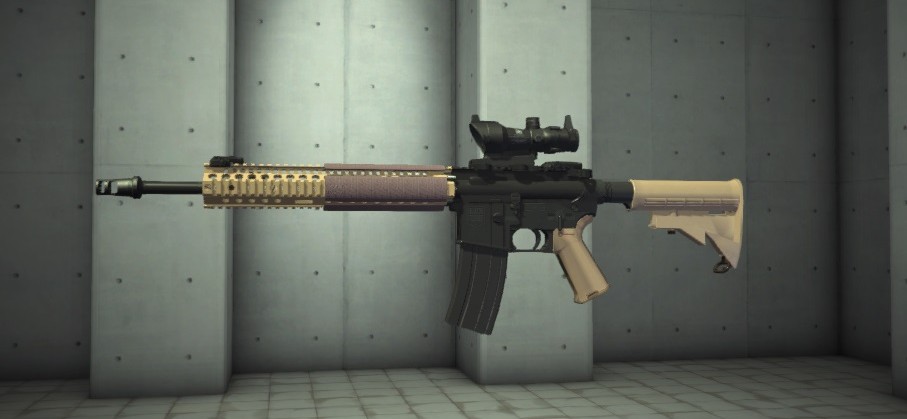
M16A4 PIP mock up: 16 inch barrel with mid-length gas system, Daniel Defense rail, compensator, telescoping stock… overall it looks very similar to a off the shelf civilian rifle. This is one version of two PIP rifles.
The M16A4 PIP was a fantastic update to the M16 that may never see the light of day. The program produced a modern iteration of the M16/AR15 weapon systems utilizing components that civilians have used for years. It features slightly improved ballistics over the M4, a softer shooting mid-length gas system, a free float barrel which would benefit both platforms, and keeps the telescoping stock. It’s a meld between the M16A4 pole-arm and the M4 carbine with improvements on both.
Of course the military scrapped the program.
So when I set about building my rifle, I took the overall design philosophy from a blending of military and civilian ideals. Who are the best civilian shooters and what are they using to win competitions? How can I turn the race gun concept they use into a durable, and capable modern weapon system? I believe I melded the best features of the AR15 from the civilian side and military side of the coin. A race gun that’s a tough, fighting rifle. General Purpose as Hell and a Rifleman’s rifle. After running this gun for almost a year now, I will be modeling all future builds off the following design philosophy:
- The 5.56 cartridge needs all the velocity / efficiency it can get: 16-18 inch barrels
- A rifle running 5.56 should operate as efficiently as possible and mitigate component stress: mid length and rifle length gas systems
- It should be build using modern and improved components: monolithic or improved rail interfaces, Vltor A5 stock system
- Glass should take priority over iron sights
So what makes my rifle?
Component Breakdown:
Criterion Hybrid Profile 18inch Barrel
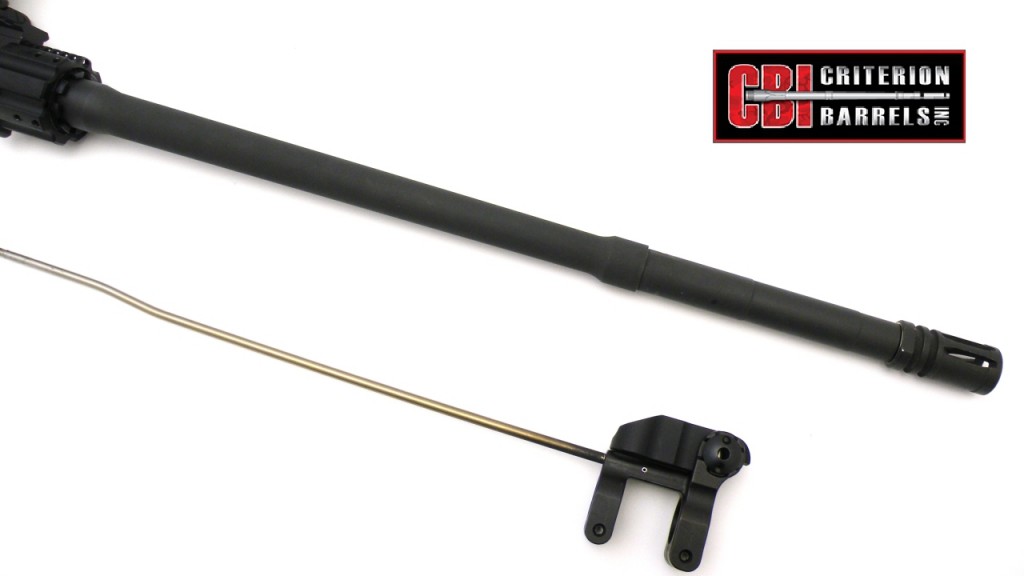
This product offers the shooter a “match grade” chrome lined, externally phosphated barrel assembly in a tapered profile. Sticking with tradition, I chose a chrome lined barrel for barrel life longevity and retention of accuracy. The chrome lining should help prevent throat erosion for many more rounds than a stainless barrel, thus preserving some of the match grade accuracy that went into the creation of this product. The thick-at-the-rear profile with the gradual taper helps manage heat near the chamber and manage weight towards the muzzle. So far the Criterion has worked as advertised, and for a balls to the wall rifle that can do anything, the CBI barrel is a good choice.
Going 18 inches allows me versatility with my loadings. I believe in matching a cartridge with a barrel length that offers efficient use of the powder. Efficient powder burn gets me more bang for my buck if you will. If I spend all that time re-loading bullets… why do I want to waste some of the money in a fireball out of a SBR? The efficiency of 18 inch barrels allows me to extract all the velocity I can out of my reloads, and that results in less wind drift and a flatter trajectory.
A rifle built for versatility would benefit most from a 16-20 inch barrel when chambered in 5.56.
Aero Precision M4E1
The AP M4E1 upper receiver was another specific part I chose for the build due to its qualities. The AP M4E1 has a direct bolt on rail assembly that has a large amount of contact area with the rail and bolts into place with 8 hex screws. This large area of interface between the rail and the receiver resulted in an extremely tight fit between the rail and upper. When installed, I believe the stiffness of the rail is only bested by monolithic systems. Being that it’s user serviceable and can be replaced if damaged, the rail suited my needs for a modern rifle while not breaking too far with conventional AR15 design. I don’t need battle worn markings or upper receivers in the shape of a dragon. Not my style. I need something modern and I see the M4E1 as an awesome upgrade over traditional receivers.

After studying the M4E1, I struck up a conversation with Aero Precision about the platform. I was convinced and ordered it. Expectations were exceeded.
The Razor HD II
The Razor HD II… let’s see. A modern rifle should have optics. Master the irons, and move on. Optics allow you to realize the full potential of the rifle and projectile. Your naked eye cannot see distant targets very well, it sure as heck cannot identify them (friend or foe?), and they don’t help you much in the dark. Optics help with all that. Choosing the razor was a painstaking ordeal. It was hard to find that optic that was just right, but then I realized the HD could accomplish all my goals. From point-blank to 600 yards, the HD has had me covered. A flexible BDC, 1/2 minute adjustments on the windage and elevation knobs, and daylight bright illumination. It’s a good choice (among many) for a general purpose build.
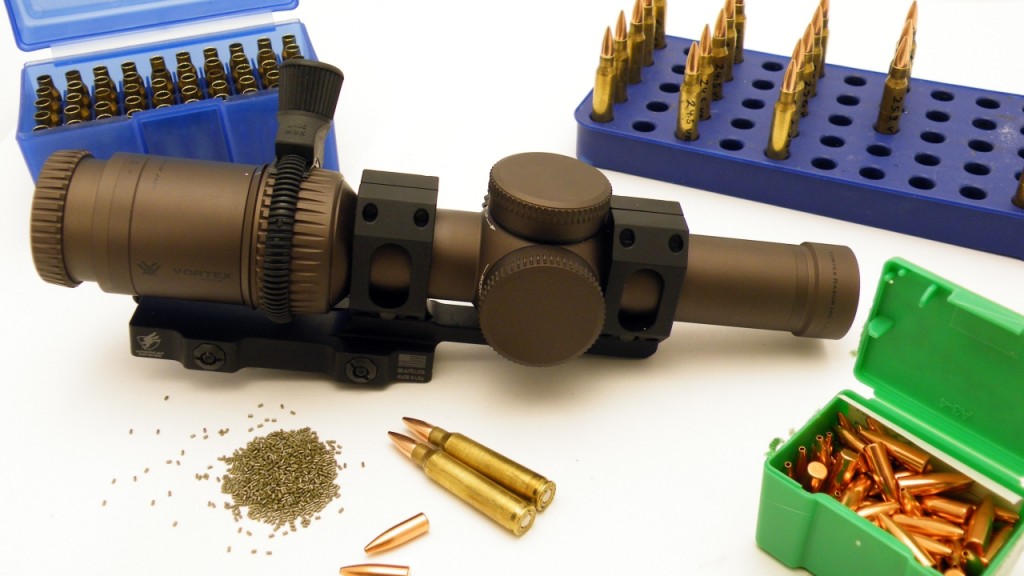
The BDC is good for my two loadings: M193 and now my 75 grain Hornady loading. To re-zero between them, I just need two clicks of adjustment and then I put the caps back on. I can use the BDC… or I can dial up my dope on the turrets. I have a bright red dot at 1x and a mid-range bullet lobber at 6x. That’s versatility.
PRI Clamp on Front Sight and Magpul MBUS Pro
The front sight is mounted to the barrel instead of the free float rail. It is important to keep the front sight off the FF rail if you are going to shoot with sling tension. Rails can flex under the strain of sling tension and this will move the front sight leading to missed shots. Keeping the sight on the barrel is a better choice for a backup sight. I liked the hood on the PRI, so I went with that. Keeping the sun off the sights will lead to a consistent sight picture without glint on the BUIS.
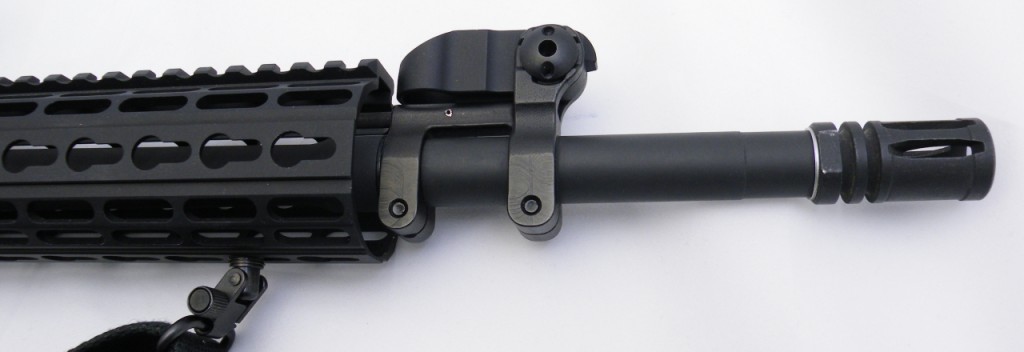
PRI clamp on: I can also swap barrels pretty easily if the CBI barrel ever wears out.
The MBUS Pro has an important feature in a rear sight: a large eye cup. Having a scalloped eye cup is a great thing as the more light you occlude from the eye, the larger the pupil dilation of the shooter. The larger the pupil dilation of the eye, the *MORE* parallax free the iron sights become when using the small peep. Some of you might be asking where on earth did I learn that. Here you go.

The rear sight is important, and Magpul put some thought into the MBUS pro.
The Lower Receiver:
The lower is nothing special save for the A5 system. I chose a VLTOR A5 assembly to ensure parts commonality between my rifles, namely the buffer spring. The extra weight of the rifle buffer adds to the reliability of the rifle. Next upgrade will be a better trigger. The rifle also features the SAP sling as a modern answer to the GI web sling and ancient leather Turner sling.
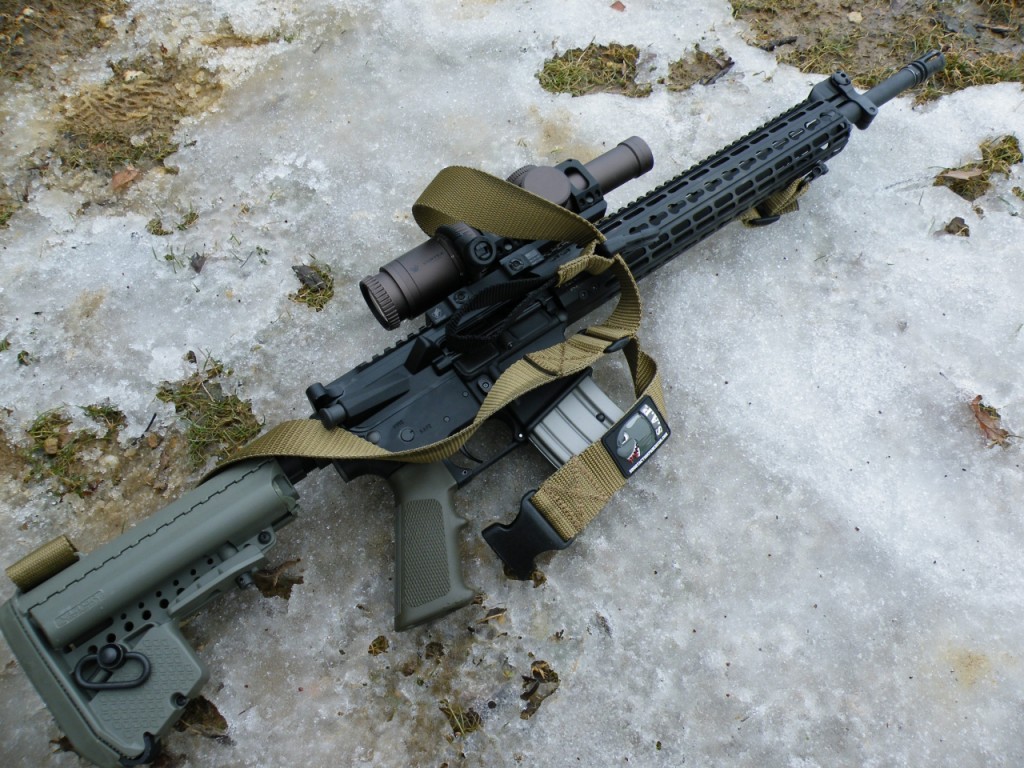
Vltor A5 stock on my rifle with a SAP sling. The Short Action Precision Sling is a modern constricting cuff type sling that offers a method for two point carry and quick slinging up.
Wrapping Up:
Build what you like. This is a hobby after all… that under certain circumstances becomes *not* a hobby, but a general purpose rifle wouldn’t be a bad thing in your inventory. Match the ballistic properties of the bullet to the barrel to ensure optimal ballistic performance. Balance the standards of quality that the military uses with the updates and modern equipment afforded to us in the civilian marketplace. Finally balance that with your needs as a civilian, law enforcement officer, etc.
Build a rifle that compliments the projectile. I don’t and wont ever own a SBR in 5.56 less than 14.5 inches (with pinned flash hider). At some point you have to ask, why am I wasting all that beautiful fireball juice outside the barrel? Why compromise the ballistics of the 5.56 over a few inches of barrel? More velocity never hurts. Better penetration, flatter trajectory, less wind drift, and less concussion are some of the benefits of keeping it > 16 inches.
The Sig brace is one of the worst products to hit the AR15 community in recent memory, but its “cool” to have what we couldn’t have before. Sure. As a side effect, we now have tons of new shooters with a specialized, short-barreled AR15 who will likely never truly understand how to shoot that rifle or why shorty ballistics are harmful to accurate riflery. It’s a dying and lost art. The knowledge of what, why, and when you should choose certain components is being replaced by what’s cool, or by marketing hype over components and junk that just don’t matter.
Do your part to fight back. Discuss why efficiency with the 5.56 is important. Educate people on WHY peep sights are more advanced than they once thought. Help people at the range understand the benefits of a modern shooting sling. Tell them why, at some point, we may need something more than a “home defense rifle” with a sig brace and 10 inch barrel.
If SHTF ever erupted, and I got to pick from a handful of rifle owners… I will pick the dude who is rocking a weapon that has a patina from lots of use, and is equipped with a high-end optic, and has some match ammo, and rolls up in a Chevy Geo. That tells me that he *uses* his rifle, he values it enough to invest his hard-earned time and money into the rifle, and that he understands why ammo selection is important.
That guy will likely be a Modern Rifleman.








I have a couple thoughts to add:
I thought your choice of the Criterion Hybrid barrel was interesting. My own favorite is my 18″ stainless White Oak SPR barrel, chambered in .223 Wylde. You may be right about the chrome lining allowing the barrel to last longer than the stainless one; that is partly offset by the slight degradation in accuracy that chrome causes. But it’s true that a general purpose rifle doesn’t need 1/2 MOA, it’s not a sniper weapon. My understanding is that the military standard for the M4 is 4 MOA; if true, this is another outstanding example of your point that civilian ARs are far better in many ways.
A melonite/nitride treated barrel in the Hybrid profile might be the best of both worlds.
I would specify, for an SHTF rifle, that it should be chambered in .223 Wylde, as the best combination of .223 accuracy and 5.56 versatility.
Also, for the rail system, many people would turn to one of the two emergent (and competing) open source lightweight “standards”: either KeyMod, as promoted by Bravo Co., or Magpul’s M-lok. My personal choice is M-lok, which I believe to be a better design, but there are plenty of supporters for KeyMod. Either one beats carrying around a lot of expensive machined rail space that you’re not using efficiently.
Finally, I think a word about triggers is appropriate. There are lots of good light match triggers; my SPR has a 3-lb trigger by Bill Springfield of Triggerwork.net (and he’s good!), but the military has sound reasons for wanting combat weapons to have a heavier trigger. A good compromise might be one of the ALG triggers. I have the Teflon-coated one in another of my rifles; it breaks at a little over 4 lbs but it meets military specs while being smooth as silk.
Just some thoughts; YMMV.
IIRC Criterion was exploring a nitride barrel assembly. On M4 Carbine.net a company had done some testing and found that Chrome still outlasted the melonite barrels by a slight margin, but the costs of bathing a barrel vs chrome lining offer substantial savings with the hat tilt to nitride.
Thanks for the link to triggerwork.net!
I did a similar exercise, and ended up with an almost identical configuration. I had not considered the PRI flip-up, though, and I think you made a good call with it over the rail mounted options I was looking at.
Im sure there are some stiff rails out there, but the clamp over barrel nut assemblys and pushing the rails longer and longer make me thing that some offset will be introduced with tension and possibly even putting the rail on a barrier.
I think you are 100% right about the longer rails and bending affecting your accuracy with irons, and I’m surprised that no one else I have seen has ever mentioned it.
Wayne,
Chrome lining has developed a poor reputation in the accuracy department largely due to the traditional practice of removing material to accommodate the chrome lining. We use a unique process that alleviates the need to remove additional material, retaining a level of bore uniformity traditionally only found in match grade stainless steel barrels. If you read the reviews of folks using our chrome lined barrels, the performance of our design speaks for itself.
Feel free to shoot me an email at [email protected] if you have any other questions about our barrels. I would be more than happy to help answer them.
-Josh
Josh, on reflection I would like to amend my comment – I know of Criterion’s reputation for supreme accuracy (and will be buying your M118LR barrel for my upcoming AR .308 build). I have no doubt your chrome-lined barrels are the exception to the general chrome lined reputation, as I’m sure they wouldn’t leave your shop without upholding Criterion’s standards.
So while I believe my comments regarding most chrome-lined barrels are correct, I’d certainly expect superior performance from a Criterion barrel, chromed or not.
Thanks for setting the record straight.
Just found this blog, and glancing over it I can appreciate the perspective and desire. I do have some thoughts on “practicalness” and general use of the M16 FOW.
To start a bit of background- I have been issued and/or have heavily used the M16A4, Mk12 Mod0 and Mod 1 SPR, “Recce” M4’s with 16in barrels, M4, M4A1, GUU-5/P, M4A1 SOPMOD BLK II, CQBR, MK18, SCAR Heavy and Light, HK416, and a whole host of guns set up for 3gun and long range matches from 6in barreled 300BO to 24in barreled varmint guns.
I say that only to give a bit of perspective for me thoughts that follow.
First is the ability to hit realistic sized targets.
I do not mean E-types as those are monstrous, I mean head/neck sized targets- max of 10-12inches. My minimum requirement for accuracy is head shots at 200m which means consistent 10 round groups of 4 inches or less- which equals close to 2 MOA. Guns that do that will consistently stay on a 12in plate at 600 yards. That is whether we’re talking about a 10.5in barrel or 18in barrel. All barrel lengths can and do meet that accuracy level with good ammo.
Second is terminal ballistics.
Until recently if you were in the conventional military (general purpose force- GPF) you were stuck with M855 which is dependent upon velocity to get adequate fragmentation. The frag range for an M4 is around 90 meters with M855 and is around 130-140m from a 20in M16. For those having to use M855 velocity was important, however that may or may not be more important than compactness. There is much improved ammunition now available to the GPF, and especially to those not hamstrung by General military regulations, such as 62gr SOST and M855A1 which offer greatly improved terminal ballistics from all barrel lengths. I have used some of the newer 62gr bullets out to just shy of 400m from 10.5in guns and they perform extremely well terminally.
Civilians have no such limitations and there have been bullets available that will reliably upset/expand well past 300m for a long time. There is zero reason for civilians to use anything but good bonded or barrier blind ammo. The 77gr Sierra Tipped Match King will produce very good tissue damage to around 550 yards from 14.5in barrels.
The bottom line with regards to terminal ballistics with 5.56 is that if I am consistently needing to, and the majority of, killing is past 300-400m then it’s time to start looking at other rounds.
Third- portability/handiness/size.
I started with the 20in guns. Quickly was issued an M4, then the SPR and then lots of versions of 10.5, 14.5 and 16in guns. My “general purpose” guns started with the 18in SPR and then after firing lots and lots of rounds I found out the 16in Recce’s did all that the 18’s did but we’re MUCH better for vehicles, inside of buildings and all around use. After a while of shooting 10.5’s and hitting all the way to 800-900m with 77gr SMK’s, I had a free float tube put on a 14.5 and it hit all the same targets as the 16in barrels did. There’s nothing wrong with 16in guns but now the longest I use as a general thing with 5.56mm is the 13.7-14.5in barrels. The SOPMOD Block II uppers are great setups and are very effective with good ammo 600m and in.
Overall the 18in and longer guns are just too long for true general use in my experience and offer little to nothing over a properly setup 14.5 or 16in carbine. Even the 10.5in guns are waaaay more effective than most believe and I have little issue using them out to 300m or a bit further.
Thanks for sharing your experiences!
My main concern with the 10.5-14.5 inch rifles is both trajectory and wind drift. Mind you, this is coming from a civilian standpoint and my research and desire to learn and understand the rifle are my driving influences in shooting and in running this blog. Any scenarios described here in are simply observations. They are in no way intended to dismiss your experiences.
One of the key areas of study (self directed study mind you) is hitting targets at unknown distances on the fly. I found that the flatter shooting the projectile, the larger window of error is permitted to the shooter on the estimate. This error was measured in yards the rounds covered while staying inside, for example, a 9 inch vertical window such as a head-shot sized target.
At 450 yards (distance unknown to the shooter, mind you) a 10.5 and a 20 inch rifle both shooting Mk 262 had different windows in which the arch of the bullet remained inside the defined target. For the 10.5 inch gun, the bullet would remain inside the 9 inch vertical space for 23 yards. For the 20 inch rifle, the bullet will remain in the 9 inch vertical space for 33 yards.
At best, what I could surmise was that 10 yards doesn’t seem like much, but that’s 10 extra yards where a shooter can err on the “exact” distance to the target and shoot… and hit the target. Holding the BDC somewhere between the 400-500 hash, there is a higher chance of being “correct” for the person shooting the higher velocity projectile where the BDC stadia are closer together.
Furthermore out of a 12.5 the observable wind drift from Mk 262 approaches that of M193 fired from a 20 inch gun IIRC.
Much of this isn’t pertinent to civilians (unless something goes terribly wrong in our nation) and I understand the concerns over longer rifles in a military setting. On my corner of the web, I just want to learn to shoot with a practical rifle, running the best components in both theory and in practice to hit targets under duress of time as quickly as possible with the highest probability to hit. In short, my question is what machine / projectile components give me the highest probability to hit a target in spite of my human error? Hence the direction the rifle has taken.
This rifle and I will be shooting for years and this rifle will be the one that readers see now and in the future. I may get “new rifles” to T&E equipment, but this one will always be here on the blog. Again thanks for the observations!
I have one more idea I think is worth adding to the “general purpose” AR concept: some barrels are faster than others.
I’m fortunate to have lucked into what appears to be one of them. I chose a 16″ lightweight barrel from AR15Performance, based on specs and value. I’ve since learned that this brand of barrels tend to chrono faster than many other brands of equivalent length. It certainly works for mine. M855 comes out at an average of 3015fps for me. I’m not 100% sure about what the secret sauce is, but it’s probably the combination of 5R rifling and the Melonite finish.
Some other barrels offer that combination, such as some S&W barrels, on select models. It would be interesting to hear from an owner if they experience the same benefit.
There are a couple of other barrels with a reputation for extra velocity as well. The Noveske 3 groove as available through MSTN is one of them.
All this to say, there may be some options for the builder who wants to maximize ballistic efficiency, but can’t bring themselves to go with an 18-20″ pipe.
What’s also of interest is that I keep hearing that stainless steel barrels offer a higher velocity compared to chrome lined barrels. I have read several threads where people discuss this, but I haven’t tested this myself yet. I have a SS barrel to test, but I have yet to do so.
Thanks for passing your knowledge and for passing info of other knowledgeable shooters and builders. This is proof to me that I have been on the right path since my first build in 2012. There has not been that much more progress since then. I purchased the best leading edge products on the market for building an upper end AR. None of these parts include optics, which can hit the one grand mark with very little effort if you buy quality. I have not installed battle sights due to poor vision. I use SS and melonite treatment which makes a big difference in hardness and longevity. Thanks, Larry, [email protected]
As a U.S. Army Retired Sergeant First Class, I big problems with your vision of the ideal weapon. The average soldier is not going to handle his weapon with enough care to maintain any amount of accuracy with the scope system you have chosen. The military branches have chosen the iron sights to have the durability that a combat zone would require. A rifle would have to have integrated front and rear sights to make it durable enough to hold up to the rigors of combat, not everyone can store their weapon in a nice little gun rack at night.
Perhaps that was true when optics were built to inferior standards in years past, but all branches are moving towards optical sights.
Irons are complex from a user perspective, and having glass simplifies shooting for the Rifleman far more than irons.
The optic that is on my rifle has seen combat in SOF roles and has proven itself in both a military use and civilian competition as a dependable and tough optic.